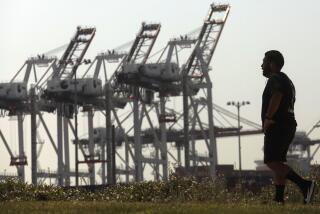‘Telecommuting’ Called Key to Cutting Pollution
- Share via
IRVINE — About 20% of the Orange County work force could work at home and help reduce traffic and smog, but they don’t because their bosses resist the notion, according to speakers at a UC Irvine transportation policy conference.
But employers must someday deal with the new realities, conference participants said. To comply with air quality regulations and boost both worker productivity and creativity, employers will have to use the computer technology that exists and become more flexible about their relationships with their workers.
“The greatest barrier,” said business consultant Paul E. Rupert, “is management’s attitude. . . . We need a new work relationship between workers and their employers . . . one that is based on trust and that measures results, not where the workers were sitting.”
The conference, which drew about 150 people from five nations and 12 states, was held at the Hyatt Regency Irvine by UC’s Institute of Transportation Studies and UC Extension.
Speakers and exhibits focused on “telecommuting”--the use of computers, telephones and fax machines to avoid work trips. Colorful slides and humorous cartoons depicted everything from farmers with telephones communicating from their cornfields to meal-in-a-car portable ovens and faxes that allow commuters to grab a meal and work while stuck in traffic.
“We have to move work to people, not people to work,” said Pacific Bell Regional Vice President Ron Del Principe, paraphrasing President Bush. “But I have to admit that business’s response has been minimal.”
A transportation planners’ buzzword since the 1970s, telecommuting is a key ingredient in smog regulators’ plans for meeting federal clean air standards. Employers with 100 or more workers face fines of $25,000 daily for not complying with trip reduction rules, and they will be given credit for each employee who spends an entire workday laboring from home.
By 2010, the South Coast Air Quality Management District wants at least 12% of the region’s workers to telecommute, while the Southern California Assn. of Governments, a six-county planning agency, is pushing for 20%.
State officials estimate that for every 10,000 people who telecommute, more than 1 million gallons of gasoline are saved. If just 5% of the workers in Los Angeles telecommuted, one study showed, 47,000 tons of pollutants would be removed from the air each day.
Current estimates for telecommuting in Southern California range from less than 1% of all workers to 9%, which includes people who work at home or at a remote, computerized work site at least one day each week.
While most of the speakers at the two-day conference were evangelical in their promotion of telecommuting, others warned that it can easily be oversold as a way to reduce freeway congestion and air pollution.
“We have to do anything that will help,” Israeli transportation expert Ilan Salomon told the conference audience. “But those who are telecommuting are largely self-selected, and they may not reflect a wide audience.”
For example, predictions that many people will telecommute might be based on false assumptions about people’s unwillingness to tolerate freeway congestion, Salomon said. “People just get used to it,” he explained, “because we believe that there’s no solution.”
And if lots of workers do not need offices now being built in central business districts, Salomon warned, real estate owners could react by lowering rents to the point where businesses would choose to bring workers back into the office. Levying fees on motorists for commuting during rush hour traffic might work better as a government policy, he said, but that is politically unpopular.
Rob Kling, professor of information and computer science at UCI, said internal problems within companies, including office politics, slow the adoption of telecommuting to the point where it is “not likely to be available to lots of people.”
Kling said 60% of the 1 million jobholders in Orange County are involved in the so-called information economy, and his preliminary studies suggest that 208,000 of these workers could telecommute a day or two a week.
They don’t, Kling said, largely because employers “aren’t taking advantage of the opportunities.”
Kling and other conference participants blamed managers’ steadfast belief that they must physically see workers at their desks as proof that they’re not “goofing off.”
“Managers think they’re in control but they’re not,” said Michael Farley, who supervises a telecommuting demonstration project for the state of Washington. “The employees are driving it. . . . They will demand it” out of concern for their quality of life.
More to Read
Sign up for Essential California
The most important California stories and recommendations in your inbox every morning.
You may occasionally receive promotional content from the Los Angeles Times.













